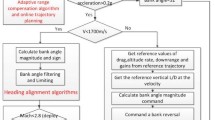Abstract
To increase the effectiveness of a glide-bomb attack, it must be able to control the direction in which it strikes the target. Since glide bombs have different characteristics from missiles, it would not be suitable to attack at the high speed; so, it is not appropriate to use the guidance laws for the typical missiles directly. While there are many similarities with TAEM guidance for re-entry vehicle, implementation on glide bombs can degrade the performance. This paper takes into consideration the characteristics of glide bomb well and proposes a robust and straightforward guidance scheme, which is also proper for an unpowered aerial vehicle. This scheme guides the vehicle to reach the ‘target window’ controlling in the desired direction with adequate potential and kinetic energy, even in strong winds. At the end of this paper, the flight tests prove the practicality of this approach.











Similar content being viewed by others
References
Shin H, Lee J, Tahk M-J (2006) Guidance synthesis to control impact angle and time. Int J Aeronaut Space Sci 7(1):129–136
Lee J, Jeon I, Tahk M-J (2007) Guidance law to control impact time and angle. IEEE Trans Aerosp Electron Syst 43(1):301–310
Shim S-W, Hong S-M, Moon G-H, Tahk M-J (2018) Impact angle and time control guidance under field-of-view constraints and maneuver limits. Int J Aeronaut Space Sci 19(1):217–226
Kim T-H, Lee C-H, Jeon I, Tahk M-J (2013) Augmented polynomial guidance with impact time and angle constraints. IEEE Trans Aerosp Electron Syst 49(4):2806–2817
Tahk M-J, Moon G-H, Shim S-W (2019) Augmented polynomial guidance with terminal speed constraints for unpowered aerial vehicles. Int J Aeronaut Space Sci 20(1):183–194
Morth R (1972) An explicit automatic terminal energy management guidance technique for space shuttle. In: AIAA guidance and control conference, Stanford, California
Moore TE (1991) Space shuttle entry terminal area management. NASA Technical Memorandum 104744, Houston, Texas
Grubler AC (2001) New methodologies for onboard generation of terminal area energy management trajectories for autonomous reusable launch vehicles. Massachusetts Institute of Technology, Cambridge
da Costa RR (2003) Studies for terminal area GNC of reusable launch vehicles. In: AIAA guidance, navigation, and control conference and exhibit, Austin, Texas
Burchett BT (2004) Fuzzy logic trajectory design and guidance for terminal area energy management. J Spacecr Rockets 41(3):444–450
Horneman KR, Kluever CA (2004) Terminal area energy management trajectory planning for an unpowered reusable launch vehicle. In: AIAA atmospheric flight mechanics conference and exhibit, Providence, Rhode Island
Morio V, Cazaurang F, Zolghadri A (2008) Onboard path planning for reusable launch vehicles application to the shuttle orbiter reentry mission. Int Rev Aerosp Eng 1(6):492–503
Morio V, Cazaurang F, Falcoz A, Vernis P (2010) Robust terminal area energy management guidance using flatness approach. IET Control Theory Appl 4(3):472–486
Jiang W, Yang Z (2014) Guidance law design for terminal area energy management of reusable launch vehicle by energy-to-range ratio. Math Probl Eng 2014:929731
Lan X-J, Liu L, Wang Y-J (2016) Online trajectory planning and guidance for reusable launch vehicles in the terminal area. Acta Astronaut 118:237–245
Mu L, Yu X, Zhang YM, Li P, Wang X (2018) Onboard guidance system design for reusable launch vehicles in the terminal area energy management phase. Acta Astronaut 143:62–75
Lawrence DA, Frew EW, Pisano WJ (2008) Lyapunov vector fields for autonomous unmanned aircraft flight control. J Guid Control Dyn 31(5):1220–1229
Frew EW, Lawrence DA, Morris S (2009) Coordinated standoff tracking of moving targets: control laws and information architectures. J Guid Control Dyn 31(2):290–306
Jung W, Lim S, Lee D, Bang H (2016) Unmanned aircraft vector field path following with arrival angle control. J Intell Robot Syst 84(1–4):311–325
Lim S, Cho S, Lee E (2018) Method for controlling approach path of gliding object. Korea Patent 10-1862927
Lim S (2013) Guidance laws using vector field to control arrival angle, time, and speed for UAVs. Ph.D. Dissertation, KAIST
Jin J-H, Park J-W, Kim B-M, Kim B-S, Lee E-Y (2009) Robust airspeed estimation of an unpowered gliding vehicle by using multiple model Kalman filters. J Inst Control Robot Syst 15(8):859–866
Dubins LE (1957) On curves of minimal length with a constraint on average curvature, and with prescribed initial and terminal positions and tangents. Am J Math 79(3):497–516
Koo S, Lim S (2019) Design of guidance law and lateral controller for a high altitude long endurance UAV. J Aerosp Syst Eng 13(2):1–9
Author information
Authors and Affiliations
Corresponding author
Additional information
Publisher's Note
Springer Nature remains neutral with regard to jurisdictional claims in published maps and institutional affiliations.
Rights and permissions
About this article
Cite this article
Lim, S., Cho, S. & Lee, E. Guidance to Control Arrival Angle and Altitude for An Unpowered Aerial Vehicle. Int. J. Aeronaut. Space Sci. 21, 1078–1091 (2020). https://doi.org/10.1007/s42405-020-00265-8
Received:
Revised:
Accepted:
Published:
Issue Date:
DOI: https://doi.org/10.1007/s42405-020-00265-8




